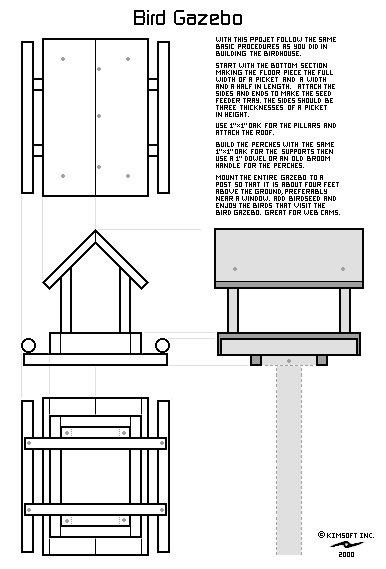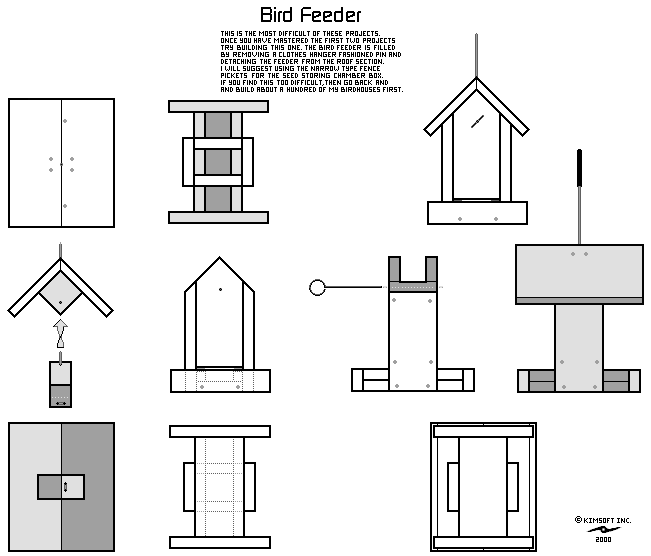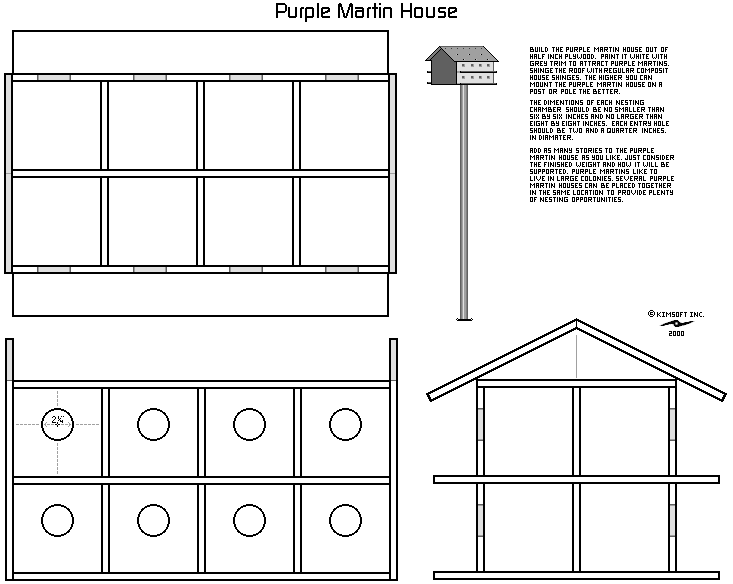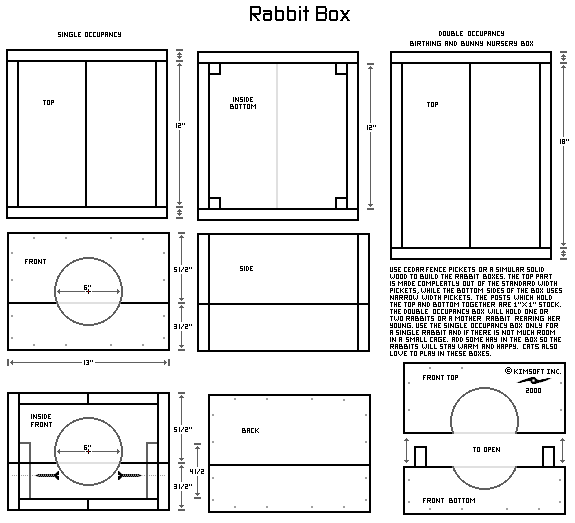
|
|

|
|





Q: Where can I find these Cedar Fence Pickets?
A: I usually find them on fences, it's a great way to recycle the old pickets and the old looking pickets make great looking Bird Houses and a rough surface for the birds to cling to. Of course you can always buy new 1" x 6" stock at the lumber yard if you can not find the old ones; they are about six dollars each. The pickets are not actually 6" wide; they standard usually range frome 5 1/2 inches to 5 3/4 inches wide and about 1/2 to 3/4 inch thick, and narrow pickets are 3 1/2 inches wide. They usually come in six or eight foot lengths. Since pickets seem to vary in width and thickness adjust your project accordingly, this is why I did not put precise measurments on these drawings. Just use the standard size pickets for all the these projects, it's just easier to use the narrow ones for some of the pieces if you have a supply of them too.
Q: Can I use nails instead of screws?
A: No! Do not use nails! Nails tend to work their way out of the wood over several seasons and the little baby birds might fall out of a house that needs repaired. Screws will also make it easier to clean the Bird Houses, just remove two of the screws on the floor panel and it will open up like a little door if you align the screws properly. You can also try the pin method for one end of the floor of the Bird House like I use on the Bird Feeder to release it.
Q: How big do I make the entry hole on the Bird House?
A: Make the hole the right size for the birds that you would like to nest in the Bird House. Different size holes attract different kinds of birds. Ask someone in your area what kind of birds to expect in your area and plan accordingly. There are many sources to refer to on the internet, bird books, the National Audobon Society, local birders, and bird watching groups. Generally the bigger the hole, the bigger the bird. Certain birds will only nest in certain size Bird Houses too. I usually make my holes exactly 1 1/2 inches in diameter for the cedar picket type bird houses, but if I find a board with a nice knot hole in it I try to use that for the hole, the hole nature made is always best. The Purple Martin entry holes are 2 1/4 inches in diameter, but can be no smaller than 1 7/8 inches for Purple Martins to fit in them. Purple Martins are very particular about their hole sizes. If Purple Martins are not nesting in your Purple Martin Houses, then please recheck your hole sizes. I have even found that some commercially made Purple Martin Houses have the wrong size holes in them.
Q: Why does the drawing say "Perch Optional, Do Not Use! For Display Only."?
A: Experts say that a Bird House should not have a perch on it because predators can use the perch to get into the Bird House, and several other reasons I will not go into. However if you are just buliding a birdhouse to display inside your home for decoration to place over the mantle, or for domestic birds in a cage, you might want to add the perch for asthetical or other reason I have mentioned. So do not put on the perch if you are going to actually use it as a Wild Bird House.
Q: Do I need to paint the Bird House and the other projects?
A: Paint is not needed when using the Cedar Fence Pickects. Cedar will last for years and years in its natural condition. If you use some other kind of wood besides Cedar, Cyprus, or Redwood you might want to seal and paint the exterior of the projects for maximum life expectency of the project. In either case, do not paint any of the surfaces where the birds will live, eat, or drink. The Purple Martin House is made of plywood, so be sure and paint all of the exterior surfaces of it to protect it from the weather.
Q: What is this Rubber Hose, do you mean Garden Hose?
A: No! Rubber Hose is Rubber Hose, like you would use for an automobile fuel line - 3/8 inch neopreme fuel line. Just ask your neighborhood shade tree mechanic for an old piece of fule line. I guess you could use a old piece of garden hose, but I think it will wear out rather quickly with the wire cutting into it, besides it is too big and it is ugly. You want a tight fit around the clothes hanger wire where it goes over the tree limb. Anything that has slack will stress the wire over time and chaff the tree branch. The tree does not like that either.
Q: Can I use rope to hang the Bird House instead of a clothes hanger wire?
A: You can. Just make sure it is study enough not to swing around in the wind too much. I've had more luck with the clothes hangers, they seem to last five to seven years before they need replaced. I have tried various types of rope, but I found I was replacing it every year. Rope just does not hold up well in the weather. If you have some better wire use that. I just reccomend the clothes hangers for everything because it is a item that most people have laying around. You might as well put them to some good use.
Q: I forgot to put the clothes hanger wire in when I built and attached the roof to the Bird House, how do I get it in there now?
A: There are several ways to attach the wire to the Bird House. It is best to attach it to a couple of srews when putting the roof together. If you forgot to do this then run the clothes hanger wire all the way through the Bird House just under the peak of the roof and fold both ends up to make the typical looking clothes hanger and twist it where the two wires come together. It should be easy to push the wire through the peak of the roof of the Bird House just over the entrance hole, all the way through and out the back at the same spot. You could drill some little holes in each end, but it you are drilling holes just drill the hole in the top center of the roof and put the wire through that like it is supposed to be. Then work it out the the entry hole and tie a little wire loop in the end. Pull it back again until its snug with the roof, that should work just as well, but the Bird House will not be as stable as if it had been attached properly.
Q: I live in Australia, do I face my bird houses South East?
Well the direction actually depends on your climate. During cool nesting months turn the bird house entrance towards the sunrise, and in a hot climate face the entrance opposite of the sun. This means face it south in the southern hemisphere, or north in the northern hemisphere. If a bird is nesting do not adjust the direction. If the nestlings have left the nest in the spring, remove the nesting debris and rotate the direction for second bird to use the bird house for a summer brood. This will keep the baby birds from over heating in a hot climate and encourage other birds to use the same bird house as well. The reference I used was in winter time in the northern hemisphere, so let me clarify that. South East is a fine direction for Australia in the summer.
Q: Do you have any plans for Butterfly or Bat Houses?
A: Yes, but just remmeber NEVER TOUCH A BAT! I'm sure you can find these plans on the net as well from another source. I'm not a bat or butterfly expert. I do know a bat can eat a lot of mosquitoes, and Purple Martins prefer Dragon Flies which eat Misquito Larvae, which kind of sounds self defeating to me. A small bat box with a few bats would therefore be better control of the mosquito population than a whole bunch of Purple Martins which would just be fun to watch.
DO NOT use cedar fence pickets to build a Butterfly House. Cedar repeals insects and butterflys are of course insects. This is why cedar is great for repealing moths and other insects in a cedar chest or closet. So use pine or some other type of wood besides cedar when building butterfly houses. You can place a ripe unpeeled bannana in a Cedar Bird Gazebo to attract butterflies without harming the butterflies. They just do not like to go into a cedar butterfly house to spend the night.
Q: How do I line up the pillars on the Bird Gazebo with the roof, to know where to drill the holes for the screws?
A: Good Question. Here is the trick: First drill the holes in the tops of the pillars, then set some small finishing nails down in the holes. Then place the roof on top of the nails until it looks right, press it down real hard and this will mark where to drill the holes in the roof. Then drill them from the underside. Remove the nails, then put in the screws.
Q: I noticed on a picture of your Bird Gazebo that the pillars seemed to have measurements marked on them, are they for measuring the birds?
A: Actually that was quite by accident, but if you see a bird 12 centimeters high last seen flying south please call the authorities. He was a suspect in assaulting some other birds. Really I came across some tank measuring sticks; brand new that had never been used and were disguarded by someone. Like the one's they use at gas stations to measure the level of gasoline in the tanks. They seemed to be just the right size and strength to use for the pillars in the Bird Gazebo and in the Rabbit Boxes, so I put them to good use. The markings where purely coincidental. I guess you could add some markings to any piece of wood that you use for the pillars if you want to have the same look or if you really want to measure the birds. The marks are are at half centimeter widths with each centimeter marked just like on a ruler. I do know it's easy to focus the web cam on the markings that are on there if you would like to try it for that.
Q: How do I get the pin to line up on the Bird Feeder?
A: Use a soft wood 2 x 4 and trim it carefully to make the plug top for the feeder that attaches to the roof that the pin will go through. Drill the hole for the pin the last thing you do; when the whole thing is built and fitting together real good. Make sure you start right on the center line. If you want an exceptionaly well fitting pin use a piece of clothes hanger for the drill bit. That makes the perfect size hole for the pin. Make the loop in the pin by wraping it around a broom stick or simular round obect, then make sure the pin part is smooth and straight. Scrape all of the varnish off of the pen with a knife and then sand it with some 400 grit sand paper so that it is extra slick. Cut the length of the pin so that it is almost flush with the other side. If you do this like me, the roof shoud fit in either direction, and the pin will work from either side. It takes some practice. Dip the loop of the pin into some black liquid rubber and let it dry for a real professional looking pull pin.
Q: How do I attach the wire to the Bird Feeder with that big wooden block in there?
A: The hanger wire runs through the center of the block at the top, then goes off at an angle to one side. Then where the wire comes out the bottom of the block; make a small loop in the wire, bend it over, and attach it to the block with a screw. If you run the wire straight down the center of the block it will conflict with the the removable pin. Use a piece of clothes hanger wire to drill the hole where the wire will run all the way through the roof and the wooden block.
Q: No birds are coming to my Gazebo, what's wrong?
A: Perhaps you did not put anything the birds like to eat in the Bird Gazebo. Try some bird seed, crackers, bread crumbs, or some peanut butter mixed with some seeds. Just be patient, the birds will come, they love the Bird Gazebo. If you are out of bird seed place a plastic tray of fresh water in the Gazebo, because birds are usally hungry as well as thirsty. Refill the plastic tray daily with fresh water. If your Gazebo goes empty for too long the birds will not come to the Gazebo, but they will return when the Gazebo bar is restocked.
Q: Where do I get a plastic tray that will fit in my Gazebo?
A: Use one of those plastic things that microwave macoroni and cheese comes in, it should fit just right.
Do you get a lot of birds in your Gazebo?
A: Yes, I've counted as many as 22 birds in the Gazebo at one time. About 20 different species of birds visit it regularly.
Q: How do I attract Cardinals to the Bird Gazebo?
A: Cardinals like the small Black Oil Sunflower Seeds, fill your Gazebo with them. Other kinds of seeds attract other kinds of birds. Fench and Finnel seeds attract Fenches, Corn attracts Crows, and large sunflower seeds attract squirrels. Put out the kind of bird seed that the birds you want to see like to eat.
Q: Do I really need to shingle the roof of the Purple Martin House?
A: Yes, because the Purple Martin House is made out of plywood you should most deffinately shingle the roof. This will help it to shed the rain water and keep the inside of the Purple Martin House dry, and it will protect the roof as well. It is not just an asthetic shingled roof, it serves a purpose, just like any shingled roof does.
Q: How high up does the Purple Martin House have to go up?
A: I would say 20 feet at minimum, but it you can get it 40 or 60 feet up in the air that is even better. If you have ever visited Lake Charles, Louisanna you might have noticed that the Purple Martin Houses at the Civic Center are 200 to 250 feet in the air. If someone can verify this and perhaps send me a photo of them I would appreciate it.
Q: Won't the rabbits chew on the Rabbit Box?
A: Rabbits might chew slightly on anything new in their cage. However as soon as the rabbits figure out that the box gives them extra shelter when they are inside it or resting or sitting on top of it, they will soon ignore nawing on it and become interested in other things. It is normal for the rabbits to naw on things, so give them treats to chew on and toys to play with to occupy their time. Also provide them with a resting board in their cage so they are not on the mesh of a wire cage all the time. If you have an extra big rabbit and you find them chewing around the entry hole of the Rabbit Box, then perhaps the hole is not big enough for them. Help them enlarge the hole by making it bigger. Use a wood file to remove any sharp edges around the hole, as well as the corners and edges of the Rabbit Box before you place it in their cage with them. This will discourage them from chewing on any corners or edges of the Rabbit Box. Just as pine and cedar shavings can cause liver damage in rabbits, so can cedar and pine boards if they a nawed and ingested. Instead, use Aspen Boards and Aspen Shavings with your rabbits, hamsters, and related animals.
Q: Why did the chicken cross the road?
A: To get to the Gazebo?
Q: Do you know of any other Bird and Bird House links I can find on the net?
A: Here are a few. If you have some bird links of interest please email them to me so that I might add them to the list.
The National Audobon Society
Frequently Asked Questions:
The National Audobon Society - Ask an expert about bird houses
North American Blue Bird Society
The Purple Martin Conservation Association
The Birdhouse Network
Homes for Birds - Nest Box Dimensions and Entrance Hole Size Chart
USGS - Building Nest Structures, Feeders, and Photo Blinds for North Dakota Wildlife
USGS - Where Can I Get More Information About Bird Houses, Bird Feeders, and Bat Houses?
Organization for Bat Conservation
Hummingbird.net
Kim Bob's - Garden - How to make Hummingbird Nectar for your Hummingbird Feeder